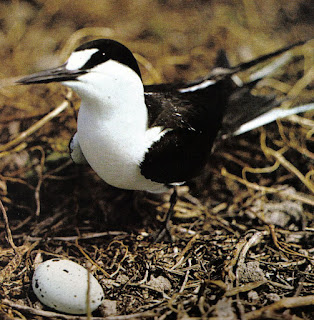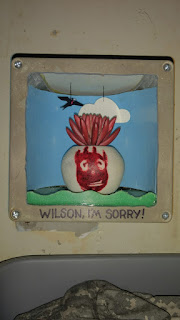End of November Update - 16 days until departure
The pelagic birds have returned in force! Most species didn't ever really leave but there have been noticeably few nests of all the species since August. It makes sense that we would not see as many birds nesting, the nesting season for most species avoids the hottest part of the year. The majority of chicks simply would not survive to fledge in the punishing heat.
The Tropicbirds, Frigates, Boobies and a few Brown Noddies still occupied Johnston during those months but we noticed the absence of the Sooty Tern colony, White Terns and Black Noddies. Just this past Wednesday Sarah and I were able to document the first Sooty Tern eggs! We had been watching the colony do their aerial mating dances for the last 5 weeks or so, and they had been teasing us with loafing behavior (meaning they just sat on the ground and LOOKED like they were incubating an egg). Finally, on the weekly check, Sarah and I noticed the Sooties were more interested in protecting their territory and convincing females to mate with them than flying away when we approached. So we got out the Trimble and Sarah mapped the initial colony size while I checked stationary individuals for eggs! I found three! It was one of the times it truly felt like I was a scientist on a nature documentary.
Having lived here for almost 6 months now, I do think I have become desensitized to the awesomeness of this expedition. I remind myself daily that I am extremely lucky to be here and what a unique experience it is. I do not have to remind myself how much I love this little island, I tell Johnston I love it every time we get a beautiful night for stargazing, or a wonderful sunset or sunrise, or when I fall asleep or wake up to the huge waves crashing on the outer reef, or every time I get a peek at the ocean from the seawall or between some trees, or every time I put on my mask and look beneath the waves . Basically I tell Johnston I love it all the time. What DOESN'T happen all the time (but happens here more often than other places) is feeling like I found something new and exciting. It's a different magic than being able to appreciate my beautiful surroundings. This magic renews my motivation to continue with the difficult parts. I also think that each little discovery is made all that more special BECAUSE of the difficult parts. If I hadn't spent months doing the same ant surveys again and again, and cutting down invasive shrub after invasive shrub (all the while sweating, burning and usually bleeding), I doubt I would be as excited about finding those three little eggs.
Anyways, back to the birds. A week ago a significant sized flock (6 individuals) of White Terns were noticed by three of us for the first time in months. I love them because of the strange sounds they make, if you have the chance you should Google a White Tern call, to me it sounds like they're trying to blow raspberries with they're silly little right-angle beak. They also like to hover over a person and make those calls like they're trying to talk to you. Unlike the Sooty Terns and Brown Noddies, two species who nest on the ground, the White Tern nest in the trees across the runway from camp and are a favorite prey for the Short Eared Owl. As I said earlier, the Sooties are back and the Brown Noddies have been seen loafing about as well. I was told that Brown Noddies and Sooty Terns have not been recorded nesting together anywhere else in the world. *Once again Johnston is special.* We have yet to see any Black Noddies return to nest. Previously there were a number of Black Noddies nesting in the trees around the internet and since we frequent that area often, I hope we'll see them as soon as they return.
Red Tails have taken over camp. We first started seeing an increase in Red Tail nests in our Reproduction Plots (the 50m square plots of nesting habitat that each of us monitor weekly) and then, BOOM, they were also all over camp. You can't sit at the dining table or in a lawn chair for more than 20 min without hearing one crash-land somewhere in camp. From noon to 1pm everyday, camp is overwhelmed with their screeches. I have no idea what they're arguing about. Each of us has at least one nest within the vicinity of our tents. Mine is located just off the trail to my tent, right at the corner of what I call my "yard". I pass it every day and sometimes check in on it while brushing my teeth. The parent has been sitting on the egg for almost 9 weeks so I am fairly certain it will never hatch. Not for lack of trying. The parent has been there every second and during our last rainstorm I fashioned a little shelter out of abandoned metal signs so it didn't get the full force of the downpour (yes, I know they are waterproof birds who live on the open ocean but I felt bad for it). Ryan's is almost fully feathered and Sarah is lucky and has a White Tail instead of the more common Red. Jake's nest has some weird drama going on; there's one nest with one egg but three adults. I am not positive, but I think the one sitting on the egg is the mother and the other two have been arguing over who is the father. They have been the loudest group in camp and have been arguing for at least 2 weeks. All three can be seen almost every day.
Just today I found the Cattle Egret rookery. It is located amongst the Boobies that nest next to the Ed Center and that is the area that most of my surveys go through. I admit that, for the last couple of weeks, I had been hearing strange bird calls coming from there, calls that I knew did not come from a Booby, but I did not investigate until today. I don't know what I expected a baby Cattle Egret to look like but they are quite ugly. There are at least 3 nests directly adjacent to one another and an average of two chicks per nest. A Cattle Egret (Bubulcus ibis) is technically not an Ibis (wrong family, Ibis belong to Threskiornithidae) or an Egret (wrong genus, the egrets are supposed to belong to Egretta), they are an altogether different genus; Bubulcus. They are considered a Heron because they belong to the family Ardeidae, along with the Great Blue Heron and the American Bittern back home. They have long necks that fold back on itself and the fluff on the chicks was thin enough I could see the gross vertebrae in it's neck. While I would expect the adult to lay it's clutch at relatively the same time, there was a significant size difference between two chicks in the same nest, so either one was getting fed more or one was more than a couple days younger.
For Thanksgiving we had a feast. I am very impressed with what we cooked up for Thanksgiving dinner;
1) Jake and Ryan produced a "Turkey" loaf made of canned turkey and bread crumbs that was also in the shape of a turkey.
2) Ryan made dinner rolls and "brookies" (a brownie-cookie)
3) Sarah made green bean casserole, stuffing, and mashed potatoes and gravy
4) Steven made teriyaki chicken and bacon wrapped green beans
5) I made two pumpkin pies, one pecan pie, apple cider and roasted broccoli, brussel sprouts, carrots and corn.
We did all this with our stupid oven that broke a few weeks ago. We already had to light the pilot light by having someone hold down the nob while you lay down on the ground and stick your arm up underneath with the lighter. Recently Steven discovered a significant amount of corrosion that causes a ton of propane to pour out, making the oven insanely hot. We have don't have a oven thermometer so we have no way of knowing for certain what temperature it is at. The knob must be left at as close to the pilot setting as possible other wise it ends up melting the plastic console at the front of the oven. Steven estimates it's at 600° when it does that (having been a plumbing welder before coming to Johnston, no one doubts he is correct). Anyway, the edges of my pies were a bit charred and the center of the brookies a bit gooey but overall it was a success.
This will most likely be the last update I send from Johnston. We're getting down to wire now, only 11 days until the next crew arrives and 16 until we leave for good. It is strange that once I leave I will never come here again. I can't think of any thing I can compare it to. Like graduating from college and never being allowed back to visit? I don't know.
P.S.
In just about 6 months CAST XVIII has;
1) cleared and applied herbicide to a total of 7.3 acres of invasive plants. All with hand tools and a single Saws-all.
2) collected, identified, and counted 96,645 individual ants.
3) counted around 15,000 Reef fish.
4) counted 198 Sea Turtles.
5) counted around 1,450 Shorebirds.
6) counted 2,533+ Red Tailed Tropicbird nests.
7) counted 73+ Great Frigate nests.
8) counted 1,433+ Red Footed Booby nests






Wow, Anna -- what an amazing adventure. Thanks for all your work to help those birds survive!
ReplyDelete